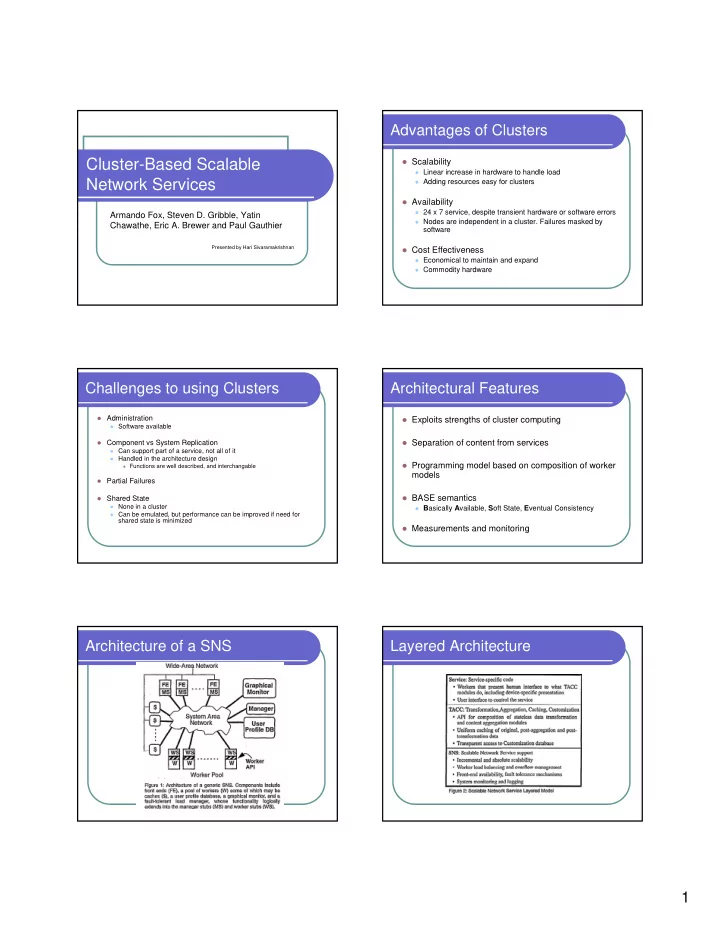

Advantages of Clusters Cluster-Based Scalable � Scalability � Linear increase in hardware to handle load Network Services � Adding resources easy for clusters � Availability � 24 x 7 service, despite transient hardware or software errors Armando Fox, Steven D. Gribble, Yatin � Nodes are independent in a cluster. Failures masked by Chawathe, Eric A. Brewer and Paul Gauthier software Presented by Hari Sivaramakrishnan � Cost Effectiveness � Economical to maintain and expand � Commodity hardware Challenges to using Clusters Architectural Features � Administration � Exploits strengths of cluster computing � Software available � Component vs System Replication � Separation of content from services � Can support part of a service, not all of it � Handled in the architecture design � Programming model based on composition of worker � Functions are well described, and interchangable models � Partial Failures � BASE semantics � Shared State � None in a cluster � B asically A vailable, S oft State, E ventual Consistency � Can be emulated, but performance can be improved if need for shared state is minimized � Measurements and monitoring Architecture of a SNS Layered Architecture 1
SNS Layer TACC : Programming model � Scalability � Transformation � Use incrementally added nodes to spawn new components � Operation on a single data object � Workers are simple and stateless � Example : encryption, encoding, compression � Centralized load balancing � Aggregation Policy implemented in manager, can be changed easily � � Collating data from various objects Trace information collected from workers, decisions sent to FEs � Fault tolerant � � Customization � Prolonged Bursts, Incremental growth � User specific data automatically fed to workers Overflow pool � � Same worker can be used with different parameter sets Workers spawned by manager � � Caching API � � ISPs observed 40 – 50 % savings…critical Provided by manager and FE to allow for new services � � Can cache original and transformed data � Worker stub handles load balancing, fault tolerance etc. � Worker code focuses on service implementation TansSend TansSend contd. � Front Ends � Fault Tolerance � SPARCstation machine cluster � Registration system used to locate distillers � HTTP interface � Timeouts detect dead nodes � Request served from cache if available or � All state is soft computed � Watcher process needs to know if peer is alive by � 400 threads periodic monitoring � Peers start one another � Load balancer � Manager starts FE � FE starts a manager � MS contacts manager to locate a distiller � Manager reports distiller failures to MS which � WS accepts requests and reports load info updates its cache � Manager spawns distiller if load increases � Programmed in the manager stubs TransSend contd. TansSend’s use of BASE � User profile database � Load balancing data � Normal ACID database � MS don’t have most recent information � Errors are corrected by using timeouts � Caching � Perf improvements outweigh problems � Harvest object cache workers � Distillers � Soft state � Image processing � Transformed content is cached � Off the shelf code � Did not have to remove all the bugs because if a node crashes, it will be restarted by a peer � Approximate answers � If system is overloaded, can return a slightly different version � Graphical Monitor of data from cache � Detect system state and resource usage � User can get accurate answer by resubmitting a request 2
Input Characteristics Cache Performance � Average cache hit takes 27ms to serve � 95% of hits take less than 100ms � Miss penalty anywhere from 100ms to 100s � Cache perf related to number of users and size � Hit rate increases monotonically with size � When sum of users exceeds cache size, hit rate falls Load balancing Scalability � Limited by shared or centralized components – � Metric – queue length at distillers SAN, manager, user profile DB � New distillers spawned � DB when load is very high � Was never near saturation in their tests � Delay D to allow for new � Manager distillers to stabilize the � Has capability to handle three orders of magnitude system before adding more traffic than the peak load more distillers � Even commodity hardware can get the job done Scalability of SAN Economic Feasibility � Close to saturation, unreliable multicast � Caching saves an ISP a lot of money traffic dropped � This information is needed by manager to � A server can pay for itself in 2 months load balance � Administration costs not considered � Workarounds � Do not expect it to be very significant � Separate network for data and control traffic � High performance interconnect 3
Conclusion � Architecture works around deficiencies of using clusters � Defined a new programming model which makes adding new services extremely easy � BASE (weaker than ACID) semantics enhances performance 4
Recommend
More recommend